Bodhi is a Buddhist term associated with enlightenment.
Contents
Bodhi may also refer to:
Bodhi is a Buddhist term associated with enlightenment.
Bodhi may also refer to:
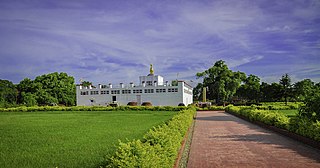
Lumbinī is a Buddhist pilgrimage site in the Rupandehi District of Lumbini Province in Nepal. It is the place where, according to Buddhist tradition, queen Maya gave birth to Siddhartha Gautama at around 623 BCE. Gautama, who, according to Buddhist tradition, achieved Enlightenment some time around 528 BCE, became Shakyamuni Buddha and founded Buddhism. Lumbini is one of many magnets for pilgrimage that sprang up in places pivotal to the life of the Buddha.

Bodh Gayā is a religious site and place of pilgrimage associated with the Mahabodhi Temple complex, situated in the Gaya district in the Indian state of Bihar. It is famous for being the place where Gautama Buddha is said to have attained enlightenment under what became known as the Bodhi Tree. Since antiquity, Bodh Gayā has remained the object of pilgrimage and veneration, for both Hindus and Buddhists. In particular, archaeological finds, including sculptures, show that the site was in use by Buddhists since the Mauryan period. Bodh Gayā and the nearby regions were invaded and destroyed in the 12th century CE by Muslim Turk armies, led by Delhi Sultanate's Qutb al-Din Aibak and Bakhtiyar Khilji.
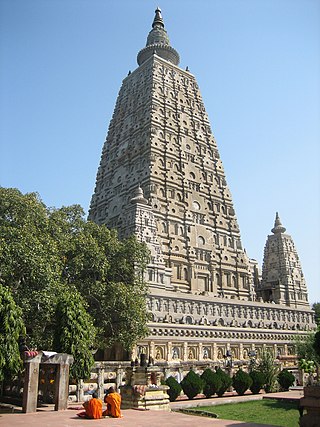
The Mahabodhi Temple or the Mahābodhi Mahāvihāra, a UNESCO World Heritage Site, is an ancient, but restored Buddhist temple in Bodh Gaya, Bihar, India, marking the location where the Buddha is said to have attained enlightenment. Bodh Gaya is 15 km from Gaya and is about 96 km (60 mi) from Patna. The site contains a descendant of the Bodhi Tree under which the Buddha gained enlightenment and has been a major pilgrimage destination of Buddhists for over two thousand years.

The Bodhi Tree, also called the Mahabodhi Tree or Bo Tree, is a large sacred fig tree located in Bodh Gaya, Bihar, India. Siddhartha Gautama, the spiritual teacher who became known as the Buddha, is said to have attained enlightenment or buddhahood circa 500 BCE under this tree. In religious iconography, the Bodhi Tree is recognizable by its heart-shaped leaves, which are usually prominently displayed.
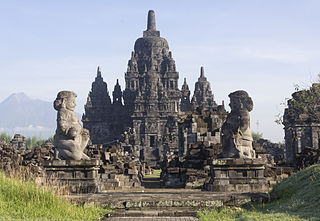
A Buddhist temple or Buddhist monastery is the place of worship for Buddhists, the followers of Buddhism. They include the structures called vihara, chaitya, stupa, wat and pagoda in different regions and languages. Temples in Buddhism represent the pure land or pure environment of a Buddha. Traditional Buddhist temples are designed to inspire inner and outer peace.
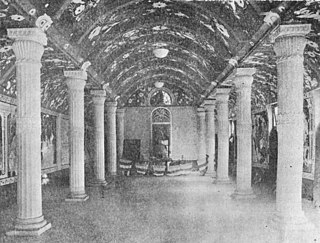
The Maha Bodhi Society is a South Asian Buddhist society presently based in Kolkata, India. Founded by the Sri Lankan Buddhist leader Anagarika Dharmapala and the British journalist and poet Sir Edwin Arnold, its first office was in Bodh Gaya. The organization's efforts began in order to resuscitate Buddhism in India, and to restore the ancient Buddhist shrines at Bodh Gaya, Sarnath and Kushinara. The restoration and revival of the glory and sanctity of Bodh Gaya are also aims of Maha Bodhi Society.

Jaya Sri Maha Bodhi Tree is a historical sacred bo tree in the Mahamewuna Garden in historical city of Anuradhapura, Sri Lanka. This is believed to be a tree grown from a cutting of the southern branch from the historical sacred bo tree, Sri Maha Bodhi, which was destroyed during the time of Emperor Ashoka the Great, at Buddha Gaya in India, under which Siddhartha Gautama (Buddha) attained Enlightenment. In 236 BC, the Buddhist nun Sangamitta Maha Theri, a daughter of Indian Emperor Ashoka, brought the tree cutting to Sri Lanka during the reign of Sinhalese King Devanampiya Tissa.[1] At more than 2,300 years old, it is the oldest living human-planted tree in the world with a known planting date. The Mahavamsa, or the great chronicle of the Sinhalese, provides an elaborate account of the establishment of the Jaya Sri Maha Bodhi on the Island and the subsequent development of the site as a major Buddhist pilgrimage site.

Ficus religiosa or sacred fig is a species of fig native to the Indian subcontinent and Indochina that belongs to Moraceae, the fig or mulberry family. It is also known as the bodhi tree, peepul tree, peepal tree, pipala tree or ashvattha tree. The sacred fig is considered to have a religious significance in four major religions that originated on the Indian subcontinent: Hinduism, Buddhism, Sikhism and Jainism. Hindu and Jain ascetics consider the species to be sacred and often meditate under it. Gautama Buddha is believed to have attained enlightenment under a tree of this species. The sacred fig is the state tree of the Indian states of Odisha, Bihar and Haryana.

Bodhi Day is the Buddhist holiday that commemorates the day that Gautama Buddha (Shakyamuni) is said to have attained enlightenment, also known as bodhi in Sanskrit and Pali. According to tradition, Siddhartha had recently forsaken years of extreme ascetic practices and resolved to sit under a peepal tree, also known as a Bodhi tree, and simply meditate until he found the root of suffering, and how to liberate oneself from it.
Siddhartha Gautama, most commonly referred to as the Buddha, was a wandering ascetic and religious teacher who lived in South Asia, during the 6th or 5th century BCE and founded Buddhism. According to Buddhist legends, he was born in Lumbini, in what is now Nepal, to royal parents of the Shakya clan, but renounced his home life to live as a wandering ascetic. After leading a life of mendicancy, asceticism, and meditation, he attained nirvana at Bodh Gaya in what is now India. The Buddha then wandered through the lower Indo-Gangetic Plain, teaching and building a monastic order. Buddhist tradition holds he died in Kushinagar and reached parinirvana.
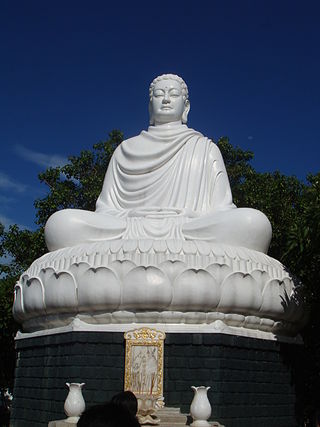
Thích Ca Phật Đài is a notable Theravada Buddhist temple in the coastal city of Vung Tau in southern Vietnam. It lies to the northwest of the Lớn mountain and was built between 1961 and 1963 when it was opened.

In Buddhism, udumbara refers to the tree, flower and fruit of the Ficus racemosa. In Buddhist literature, this tree or its fruit may carry the connotation of rarity and parasitism. It is also mentioned in Vedic texts as the source of wood for rituals and amulets.

The Emblem of Bihar is the official seal of the Indian state of Bihar. It is available on every official document and stamp. It was officially adopted by the Government of Bihar during British rule between 1930 and 1935.
Anandabodhi or Ananda Bodhi may refer to:

The Sri Lanka Maha Bodhi Centre is a Sri Lankan Buddhist establishment in Chennai, India. It is located in Egmore. It is run by the Sri Lanka Maha Bodhi Society and serves as a monument of friendship between Sri Lanka and India.

Maha Bodhi Ta Htaung is a Buddhist religious complex located in Monywa Township, Sagaing Region, Myanmar (Burma). It is known for the Giant Standing Buddha statue, the third tallest in the world, and for the Great Attitudes of U Narãda, who built the monastery. This Sāsana (religious) site contains thousands of Buddha statues beneath thousands of Bo trees, the Giant Reclining Buddha Statue, Aung Sekkya Stupa, and other large Buddha statues. Currently, a Sitting Buddha Statue, which is expected to become the world's largest Sitting Buddha Statue, is in construction. Many Buddhist monks can study the Buddhist Pariyatti literature at the monastery. Moreover, meditation centres or Vipassãnā centres are opened at this monastic site both for monks and laypersons.

Buddha Smriti Park also known as Buddha Memorial Park is an urban park located on Frazer Road near Patna Junction in Patna, India. This park has been designed by Vikram Lall and developed by the Bihar Government to commemorate the 2554th birth anniversary of the Buddha. This park was inaugurated by the 14th Dalai Lama.

Maya Devi Temple is an ancient Buddhist temple situated at the UNESCO World Heritage Site of Lumbini, Nepal. It is the main temple at Lumbini, a site traditionally considered the birthplace of Gautama Buddha. The temple stands adjacent to a sacred pool and a sacred garden. The archaeological remains at the site were previously dated to the third-century BCE brick buildings constructed by Ashoka. A sixth-century BCE timber shrine was discovered in 2013.
Bodh may refer to:

The Vajrasana, or Enlightenment Throne of the Buddha, is an ancient stone slab located under the Bodhi tree, directly beside the Mahabodhi Temple at Bodh Gaya. The slab is thought to have been placed at Bodhgayā by Emperor Ashoka The Great of the Maurya Empire between 250-233 BCE, at the spot where the Buddha meditated.